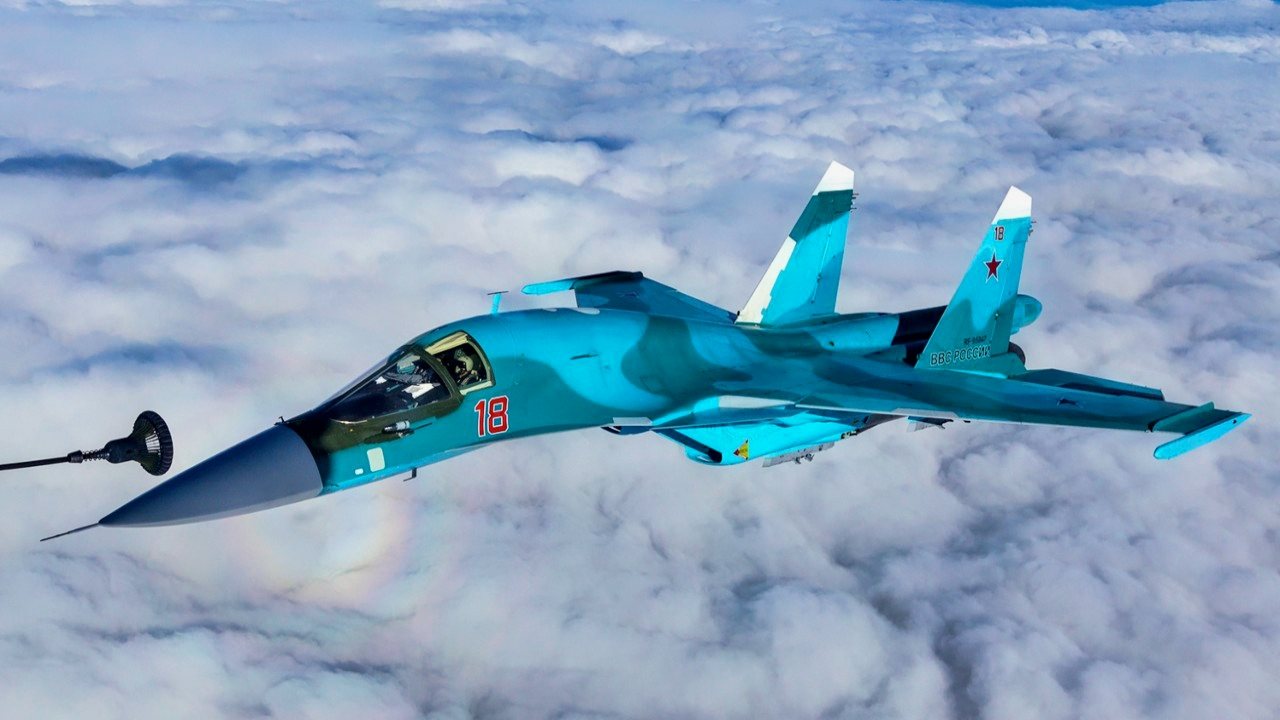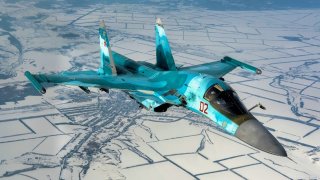Russia's Su-34 Fullback Has 'Suffered Considerable Losses'
The war has exposed the strain on Russia's Su-34 fleet, highlighting both the capabilities and limitations of this bomber. While the Su-34 has been more effective than initially expected, it also faces significant operational challenges.
Summary and Key Points: The Su-34 "Fullback" has played a central role in Russia's air offensive against Ukraine, executing precision strikes on military and civilian targets.
-Despite Western skepticism of Russian precision capabilities, the Su-34 has proven effective in targeting Ukrainian forces and air defense systems.
-However, the aircraft remains vulnerable to Ukraine's air defenses, which have successfully downed multiple Su-34s.
-The war has exposed the strain on Russia's Su-34 fleet, highlighting both the capabilities and limitations of this bomber. While the Su-34 has been more effective than initially expected, it also faces significant operational challenges.
Su-34: A Double-Edged Sword in Russia's Air Offensive Against Ukraine
A central player in Russia’s air offensive against Ukraine, the Su-34 “Fullback” (that’s the NATO designation for the warplane) has been conducting tactical bombardment of key targets in Ukraine. The Su-34 has been deployed against Ukraine’s military—and civilian—infrastructure since the early phases of the conflict.
They’ve been used to blast apart Ukrainian troop concentrations as well as Ukrainian command centers. Indeed, recent reports suggest that the Su-34 has demonstrated a high degree of effectiveness against critical Ukrainian military targets in the realm of precision airstrikes, a capability that, for many years, Western analysts have denigrated when assessing Russian air warfare capabilities.
Western-Supplied Air Defenses Complicate Russian Plans
One of the greatest problems for Russia’s air force in the war has been the presence of Western-supplied and even older Russian-built air defense systems deployed along the frontline. Until those units are neutralized either by Russian strategic bombing and/or long-range artillery and surface-to-surface missile strikes from over the horizon, the Russian air force will have difficulty dominating the skies above Ukraine.
The Su-34 has now proven to be used effectively—even at night—against these Ukrainian air defense systems. Notably, the Fullbacks were deployed to blast some of Ukraine’s S-300P missile systems along with some key command posts that those air defense networks were protecting.
Is Russian Air War Doctrine Becoming More Western?
Russia’s reliance on the Su-34 Fullback for precision strikes highlights its strategic air warfare doctrine. While Russia has been criticized (rightly so, in many cases) for egregious human rights violations in its conduct of the war, doctrinally speaking, it seems that the Russians are interested in targeting high-value military targets while seeking minimal collateral damage.
Of course, this has not stopped Russian commanders from seeking retribution or conducting horrific terror campaigns against Ukrainian civilians throughout the war.
But the fact that the Fullbacks are being deployed to first soften up Ukrainian military targets with precision-guided munitions indicates a genuine attempt at mitigating the civilian casualties from a doctrinal perspective.
Nevertheless, the Su-34’s use as a frontline air asset by Russia has made it a rich target for Ukrainian air defenses. Indeed, Ukraine’s defenders have claimed multiple successes in downing Su-34 Fullbacks. According to one report from Ukraine, as many as 26 Su-34 Fullbacks have been shot down since the Russians invaded Ukraine in February 2022. Thus, despite their reliance on the Su-34, the war has shown the world how vulnerable these bombers are to anti-aircraft systems.
Problems Facing the Su-34 Fullback
For example, the Ukrainian defenders have successfully fused their older Soviet air defense systems with newer NATO-provided platforms, like the National Advanced Surface-to-Air Missile System (NASAMS), using them with lethal effectiveness against the incoming Su-34 Fullback swarms.
As I’ve documented in these pages before, another problem for the Su-34s is that they are not operating in the ways that their designers intended. Much like American bombers during the Second World War, Russian commanders have insisted that, to ensure greater accuracy and lethality, the Su-34s conduct their strike missions closer to the ground, making them susceptible to Ukrainian air defenses.
Meanwhile, constant deployment into intense combat has placed the Su-34 fleet under significant wear and tear. This strain has contributed to combat losses, pilot fatigue, and mechanical failures that would have otherwise not occurred.
Far removed from the combat zone, a Su-34 Fullback on a training mission over North Ossetia (Georgia) crashed due to a severe mechanical failure mid-flight. Many analysts have concluded that this was not just a typical training accident. It underscored the kind of stress that the Russian Su-34 fleet was under.
Understanding the Rise of Russia’s Precision-Guided Munitions
So many Western observers have often pilloried Russian precision strike capabilities because the Russians have been behind in embracing these systems in the comprehensive way that Western air forces have.
During the 2008 Russo-Georgia War, Russian warplanes rarely deployed these systems for a variety of reasons, notably that they were too expensive. The Russians had a sparse arsenal of these munitions that the Americans and their partners take for granted.
Again, in 2013, when the Russians intervened in defense of the Bashar al-Assad regime of Syria, the Russians began attacking ISIS and other Islamist terror groups with precision-guided munitions more frequently because the Russians had spent the time since the August 2008 war against Georgia enhancing their precision-guided munitions capacity.
However, using the Su-34 as a primary frontline bomber indicates how serious the Russians are about developing an indigenous precision strike capability. What’s more, the decision by Moscow to direct significant amounts of their limited resources to build more Su-34s and more of those expensive precision-guided munitions shows that Russia is attempting to shift its image as an old-school, mad carpet bomber into a more sophisticated and modern force that uses precision strike systems first rather than the more unpredictable (but cheaper) dumb bombs.
Overcoming the Fog of War to See Reality
Another issue affecting a proper understanding of the Su-34’s performance in the Ukraine War is the propaganda both sides promote. The Ukrainians have helped to paint a picture of the Su-34 as a perennial joke in the Western press. At the same time, the Russians have turned the Su-34 Fullback into a symbol of their combat prowess.

The truth likely lies somewhere between those two extreme interpretations.
Nevertheless, the Su-34 has performed admirably, considering its age, the Russian military's newness in using massive precision-guided munition, and Ukraine's impressive air defense systems, which its Western backers have showered Ukraine with over the years.
Anyone underestimating the lethality of the Su-34 or the growing competency that Russia has in precision-guided munitions should reassess that outlook quickly.
Author Experience and Expertise: Brandon J. Weichert
Brandon J. Weichert, a National Interest national security analyst, is a former Congressional staffer and geopolitical analyst who is a contributor at The Washington Times, the Asia Times, and The-Pipeline. He is the author of Winning Space: How America Remains a Superpower, Biohacked: China’s Race to Control Life, and The Shadow War: Iran’s Quest for Supremacy. His next book, A Disaster of Our Own Making: How the West Lost Ukraine, is due October 22 from Encounter Books. Weichert can be followed via Twitter @WeTheBrandon.
All images are Creative Commons or Shutterstock.
From the Vault
Russia Freaked Out: Why the U.S. Navy 'Unretired' the Iowa-Class Battleships
Battleship vs. Battlecruiser: Iowa-Class vs. Russia's Kirov-Class (Who Wins?)


